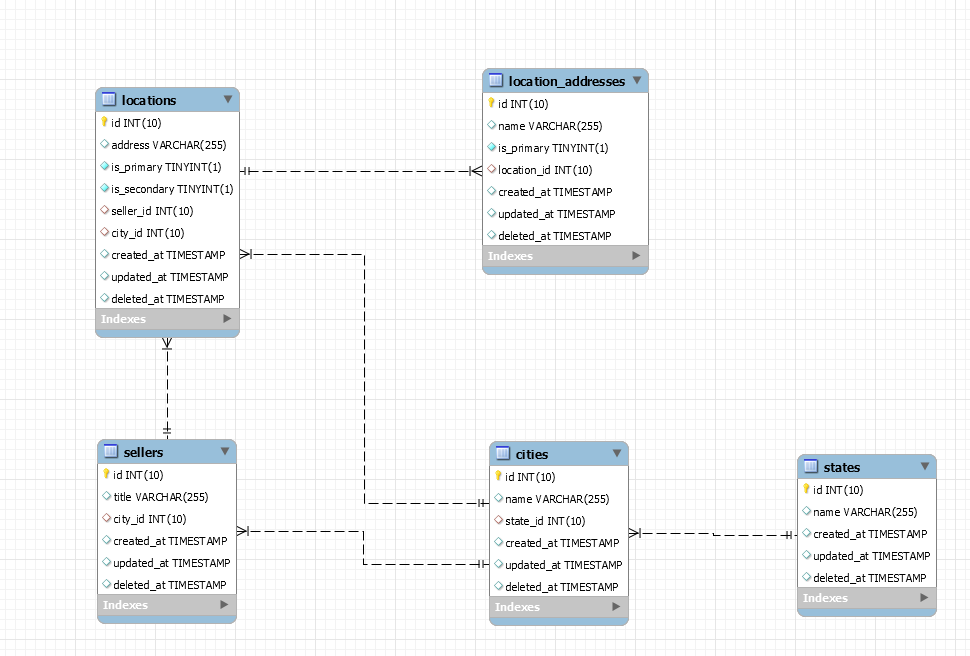anderson-dw / laravel-eloquent-join
此包引入了Eloquent模型和关系的连接魔术。
Requires
- illuminate/database: ^5.5|^6.0|^7.0|^8.0
Requires (Dev)
- dev-master
- 4.1.3
- 4.1.2
- 4.1.1
- 4.1.0
- 4.0.9
- 4.0.8
- 4.0.7
- 4.0.6
- 4.0.5
- 4.0.4
- 4.0.3
- 4.0.2
- 4.0.1
- 4.0.0
- 3.0.2
- 3.0.1
- 3.0.0
- 2.2.4
- 2.1.x-dev
- 2.1.4
- 2.1.3
- 2.1.2
- 2.1.0
- 2.0.x-dev
- 2.0.4
- 2.0.3
- 2.0.2
- 2.0.0
- 1.3.x-dev
- 1.3.4
- 1.3.3
- 1.3.2
- 1.3.0
- 1.2.x-dev
- 1.2.4
- 1.2.3
- 1.2.2
- 1.2.1
- 1.2.0
- dev-filip-patch-5
- dev-filip-patch3
- dev-filip-patch2
- dev-filip-patch
This package is auto-updated.
Last update: 2024-09-22 03:21:32 UTC
README
FORK以支持Laravel 10
Laravel Eloquent Join
此包引入了Eloquent模型和关系的连接魔术。
简介
Eloquent是一个功能强大的ORM,但其连接功能非常有限。
第一个Eloquent问题(排序)
使用Laravel,您无法在不手动连接相关表的情况下对关系字段进行排序,这非常不自然。让我给你几个原因。如果您有一个包含posts和相关的categories的表,您的代码可能看起来像这样:
$posts = Post::select('posts.*')
->join('categories', 'categories.id', '=', 'posts.category_id')
->groupBy('posts.id')
->where('categories.deleted_at', '=', null)
->orderBy('categories.name');
if(request()->get('date')){
$posts->where('posts.date', $date)
}
$posts = $posts->get();
1. 第一个问题是你需要担心选择。
->select('posts.*')
原因:没有从category中select id,它可能被选中并注入到Post模型中。
2. 第二个问题是您需要担心groupBy。
->groupBy('posts.id');
原因:如果关系是HasOne并且帖子有多个类别,查询将返回多个类别的行。
3. 第三个问题是您需要将所有其他where子句从
->where('date', $date)
改为
->where('posts.date', $date)
原因:一个post和category可以有一个“date”属性,在这种情况下,如果没有选择具有表“模糊列”的属性,将会抛出错误。
4. 第四个问题是您正在使用表名(不是模型),这也不好,也不自然。
->where('posts.date', $date)
5. 第五个问题是您需要担心连接表的软删除。如果category使用了SoftDeletes特性,您必须添加
->where('categories.deleted_at', '=', null)
此包将为您处理上述所有问题。与排序不同,您可以在不连接相关表的情况下对关系字段进行过滤,但此包将提供更简单的方法来实现这一点。
第二个Eloquent问题(子查询)
使用Laravel,您可以在关系属性上执行where操作,但Laravel会生成比连接更慢的子查询。使用此包,您将以优雅的方式执行具有连接的关系的where操作。
要求
包还针对SQLite、MySQL和PostgreSQL进行了测试
安装和设置
1. 使用Composer安装包
composer require fico7489/laravel-eloquent-join
使用此语句,Composer将安装与您当前Laravel版本兼容的最高版本包。
2. 在您的基模型或特定模型中使用Fico7489\Laravel\EloquentJoin\Traits\EloquentJoinTrait特性。
...
use Fico7489\Laravel\EloquentJoin\Traits\EloquentJoin;
use Illuminate\Database\Eloquent\Model;
abstract class BaseModel extends Model
{
use EloquentJoin;
...
3. 重要
对于MySQL,请确保strict配置设置为false
config/database.php
'mysql' => [
...
'strict' => false,
...
就是这样,您可以开始了。
选项
选项可以在模型中设置
class Seller extends BaseModel
{
protected $useTableAlias = false;
protected $appendRelationsCount = false;
protected $leftJoin = false;
protected $aggregateMethod = 'MAX';
或查询上
Order::setUseTableAlias(true)->get();
Order::setAppendRelationsCount(true)->get();
Order::setLeftJoin(true)->get();
Order::setAggregateMethod(true)->get();
useTableAlias
是否应该为连接表使用别名(默认 = false)
使用true,查询将如下所示:
select "sellers".* from "sellers"
left join "locations" as "5b5c093d2e00f"
...
使用false,查询将如下所示:
select "sellers".*
from "sellers"
left join "locations"
...
别名是随机生成的字符串。
appendRelationsCount
是否应该自动将关系计数字段附加到结果(默认 = false)
使用true,查询将如下所示:
select "sellers".*, count(locations.id) AS locations_count
from "sellers"
left join "locations" as "5b5c093d2e00f"
...
每个relation都用下划线连接,并在末尾添加前缀_count。例如,对于
->joinRelations('seller.locations')
字段将是seller_locations_count
leftJoin
是否应使用inner join或left join(默认 = true)
select "sellers".*
from "sellers"
inner join "locations"
...
vs
select "sellers".*
from "sellers"
left join "locations"
...
aggregateMethod
用于排序的聚合方法(默认 = 'MAX')。
当对连接表执行连接操作时,我们必须在排序字段上应用聚合函数,以便执行分组子句并防止结果重复。
select "sellers".*, MAX("locations" ."number") AS sort
from "sellers"
left join "locations"
group by "locations" ."id"
order by sort
...
选项包括: 求和,平均值,最大值,最小值,计数
用法
当前可用于连接查询的关系
- 属于
- 有一个
- 有多个
针对 BelongsTo 和 HasOne 关系的 Eloquent 生成器的新子句
joinRelations($relations, $leftJoin = null)
- $relations 要连接的关系
- $leftJoin 使用 左连接 或 内连接,默认为 左连接
orderByJoin($column, $direction = 'asc', $aggregateMethod = null)
- $column 和 $direction 参数与默认 Eloquent orderBy() 中的参数相同
- $aggregateMethod 参数定义要使用的聚合方法(求和,平均值,最大值,最小值,计数),默认为 最大值
whereJoin($column, $operator, $value, $boolean = 'and')
- 参数与默认 Eloquent where() 中的参数相同
orWhereJoin($column, $operator, $value)
- 参数与默认 Eloquent orWhere() 中的参数相同
whereInJoin($column, $values, $boolean = 'and', $not = false)
- 参数与默认 Eloquent whereIn() 中的参数相同
whereNotInJoin($column, $values, $boolean = 'and')
- 参数与默认 Eloquent whereNotIn() 中的参数相同
orWhereInJoin($column, $values)
- 参数与默认 Eloquent orWhereIn() 中的参数相同
orWhereNotInJoin($column, $values)
- 参数与默认 Eloquent orWhereNotIn() 中的参数相同
在 BelongsTo、HasOne 和 HasMany 关系上允许使用的子句,在这些关系上可以使用连接子句进行查询
- 您想要用于连接查询的关系只能有这些子句: where,orWhere,withTrashed,onlyTrashed,withoutTrashed。
- where 和 orWhere 子句只能有这些变体 ** ->where($column, $operator, $value) ** ->where([$column => $value])
- 不允许使用闭包。
- 不允许使用其他子句,如 whereHas,orderBy 等。
- 您可以在关系上添加不允许的子句并以正常的 Eloquent 方式使用它们,但在这些情况下,您不能使用这些关系进行连接查询。
允许的关系
public function locationPrimary()
{
return $this->hasOne(Location::class)
->where('is_primary', '=', 1)
->orWhere('is_primary', '=', 1)
->withTrashed();
}
不允许的关系
public function locationPrimary()
{
return $this->hasOne(Location::class)
->where('is_primary', '=', 1)
->orWhere('is_primary', '=', 1)
->withTrashed()
->whereHas('state', function($query){return $query;}
->orderBy('name')
->where(function($query){
return $query->where('is_primary', '=', 1);
});
}
不允许第二个关系的原因是,这个包应该在连接子句上应用所有这些子句,Eloquent 使用子查询将所有这些子句隔离起来,而不是在连接子句上,这样做更简单。
您可能会觉得规则和限制太多,但实际上并不是这样。请放心,如果您创建了不允许的查询,将会抛出适当的异常,并且您会知道发生了什么。
其他
- 如果模型使用了 SoftDelete 特性,则将自动应用 where deleted_at != null
- 您可以无限次地组合新子句
- 如果您在相同的关系上组合子句更多次,则包将只连接相关表一次
Seller::whereJoin('city.title', '=', 'test')
->orWhereJoin('city.title', '=', 'test2');
- 您可以在闭包内部调用新子句
Seller::where(function ($query) {
$query
->whereJoin('city.title', '=', 'test')
->orWhereJoin('city.title', '=', 'test2');
});
- 您可以将连接子句(例如,whereJoin())与 Eloquent 子句(例如,orderBy())组合
Seller::whereJoin('title', '=', 'test')
->whereJoin('city.title', '=', 'test')
->orderByJoin('city.title')
->get();
查看真实示例上的操作
数据库模式
模型
class Seller extends BaseModel
{
public function locations()
{
return $this->hasMany(Location::class);
}
public function locationPrimary()
{
return $this->hasOne(Location::class)
->where('is_primary', '=', 1);
}
public function city()
{
return $this->belongsTo(City::class);
}
class Location extends BaseModel
{
public function locationAddressPrimary()
{
return $this->hasOne(LocationAddress::class)
->where('is_primary', '=', 1);
}
class City extends BaseModel
{
public function state()
{
return $this->belongsTo(State::class);
}
}
连接
连接 BelongsTo
Seller::joinRelations('city')
连接 HasOne
Seller::joinRelations('locationPrimary')
连接 HasMany
Seller::joinRelations('locations')
连接(混合左连接)
Seller::joinRelations('city.state')
连接(混合左连接)
Seller::joinRelations('city', true)->joinRelations('city.state', false)
连接(多个关系)
Seller::join(['city.state', 'locations'])
排序
排序 BelongsTo
Seller::orderByJoin('city.title')
订单一对一
卖家::按连接排序('locationPrimary.address')
订单多对多
卖家::按连接排序('locations.title')
订单混合
卖家::按连接排序('city.state.title')
排序(使用聚合函数的特殊情况)
按关系数量排序
卖家::按连接排序('locations.id', 'asc', 'COUNT')
按关系字段排序 SUM
卖家::按连接排序('locations.is_primary', 'asc', 'SUM')
按关系字段排序 AVG
卖家::按连接排序('locations.is_primary', 'asc', 'AVG')
按关系字段排序 MAX
卖家::按连接排序('locations.is_primary', 'asc', 'MAX')
按关系字段排序 MIN
卖家::按连接排序('locations.is_primary', 'asc', 'MIN')
过滤(where 或 orWhere)
过滤属于
卖家::whereJoin('city.title', '=', 'test')
过滤一对一
卖家::whereJoin('locationPrimary.address', '=', 'test')
过滤多对多
卖家::whereJoin('locations.title', '=', 'test')
过滤混合
卖家::whereJoin('city.state.title', '=', 'test')
关系计数
$sellers = Seller::setAppendRelationsCount(true)->join('locations', '=', 'test')
->get();
foreach ($sellers as $seller){
echo 'Number of location = ' . $seller->locations_count;
}
过滤(混合左连接)
Seller::joinRelations('city', true)
->joinRelations('city.state', false)
->whereJoin('city.id', '=', 1)
->orWhereJoin('city.state.id', '=', 1)
生成的查询
查询
Order::whereJoin('seller.id', '=', 1)->get();
Sql
select "orders".*
from "orders"
left join "sellers" on "sellers"."id" = "orders"."seller_id"
where "sellers"."id" = ?
and "orders"."deleted_at" is null
group by "orders"."id"
查询
Order::orderByJoin('seller.id', '=', 1)->get();
Sql
select "orders".*, MAX(sellers.id) as sort
from "orders"
left join "sellers" on "sellers"."id" = "orders"."seller_id"
where "orders"."deleted_at" is null
group by "orders"."id"
order by sort asc
包的优雅性
让我们看看文档中的第一个示例现在看起来像什么。这段代码
$posts = Post::select('posts.*')
->join('categories', 'categories.id', '=', 'posts.category_id')
->groupBy('posts.id')
->where('categories.deleted_at', '=', null)
->orderBy('categories.name');
if(request()->get('date')){
$posts->where('date', $date)
}
$posts = $posts->get();
现在
$posts = Post::orderByJoin('category.name');
if(request()->get('date')){
$posts->where('posts.date', $date)
}
$posts = $posts->get();
两个片段做同样的事情。
测试
此包经过良好的测试覆盖。如果您想运行测试,只需运行 composer update 然后使用 "vendor/bin/phpunit" 运行测试
贡献
请随时为新问题创建
- 错误
- 通知
- 请求新功能
- 问题
- 澄清
- 等...
许可
MIT
自由软件,太棒了!

